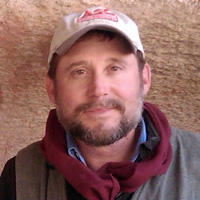There is, hanging in the long hallway of my parent's house, a large painting. I've never spoken to my mother about the painting until now. She has pulmonary fibrosis, and is now on oxygen 24/7. She is an award-winning artist, and there are paintings that I have questions about, images from her art that have stayed with me over the years, and I'm looking for answers about this one.
Most of her work over the past decade has been pastels, vibrant ultraviolet landscapes that prove to me that she can see ranges of light beyond the rest of us. This painting, however, is in black and white, except for one crucial detail.
The painting is from a photo in William Stevenson's book "A Man Called Intrepid." It's of a woman named Madeline, the first woman British World War II radiotelegraphist who transmitted from occupied France. She was caught by the Gestapo. She sits naked and emaciated, one of the Gestapo men holding her head up for the photo. There are no faces other than hers, just the legs of the men standing behind her. In the photo, she looks away, and does her best to cover herself before execution.
The painting has a secret. Up close, at eye level, you can see in the shadows of Madeline's eye sockets that my mother has painted two tiny red dots. I wanted to know about those two dots. With those two tiny dots, my mother has transformed Madeline, from victim to something else -- a force of vengeance. The man's hand, holding her head, has rotted away, every man in the picture now dead and defeated. Madeline wears a halo of amputated limbs.
The painting is as beautiful as it is horrifying. It reminds me of the true power that an artist has to re-forge images of despair into those of triumph, even a horrible triumph, and I love my mother even more for painting it. I imagine, in her, the same burning coals, the unflinching stare, as she faces the disease slowly taking her breath away.
